

During the Second World War, the German-Jewish Frank family and four other Jews had to hide from the National Socialists in Amsterdam. During this time, 13-year-old Anne Frank recorded her thoughts and feelings in her diary. However, she also described everyday life in the secret annex and the overwhelming fear of being discovered. The diary ends on 1 August 1944; three days later the secret annex was discovered, and Anne died seven months later in the Bergen-Belsen concentration camp. After the war, the various diaries written by his daughter were returned to Anne's father who had extracts from them published for the first time in 1947. The complete version of the Diary of Anne Frank has so far been published in more than 70 languages. Many revised versions have also been published. The globally binding version that was published in 1991 contains all the sections of the original diary.
«You’ve known for a long time that my greatest wish is to be a journalist, and later on, a famous writer. We’ll have to wait and see if these grand illusions (or delusions!) will ever come true, but till now I’ve had no lack of topics. In any case, after the war I’d like to publish a book called The Secret Annex. It remains to be seen whether I’ll succeed, but my diary can serve as the basis.»
Diary, 11 May 1944
Anne Frank celebrate her 13th birthday on 12 June 1942. In a state of great excitement, she is allowed to enter the living room shortly after 7 am, where her presents are waiting. Her favourite gift is a red-and-white checked autograph album that she selected herself a few days earlier. It is to become her diary. She writes her first entry that very day:
«I hope I will be able to confide everything to you, as I have never been able to confide in anyone, and I hope you will be a great source of comfort and support.»
In her first entries, Anne describes her school friends and writes about her family and everyday life in Merwedeplein in Amsterdam. She soon starts to write her entries as letters to imaginary friends. The most important of these friends is called Kitty.
«No, on the surface I seem to have everything, except my one true friend. All I think about when I’m with friends is having a good time. I can’t bring myself to talk about anything but ordinary everyday things. We don’t seem to be able to get any closer, and that’s the problem. Maybe it’s my fault that we don’t confide in
each other. In any case, that’s just how things are, and unfortunately they’re not liable to change. This is why I’ve started the diary.
To enhance the image of this long-awaited friend in my imagination, I don’t want to jot down the facts in this diary the way most people would do, but I want the diary to be my friend, and I’m going to call this friend Kitty»
Diary, 20. June 1942
Anne was a German Jew. Together with her parents, she emigrated from Frankfurt am Main to Amsterdam in early 1934 to escape Nazi repression and persecution. Following the occupation of the Netherlands by the German army in 1940, the situation became increasingly restricted and threatening for Jews in Amsterdam, too.
Early summer 1942 saw the start of the systematic deportation of Jews from the Netherlands. Margot Frank, Anne’s sister, was one of the first to receive a summons for “labour duty in Germany” on 5 July 1942. The summons was compulsory and meant separation from one’s family and deportation to a concentration camp. Otto and Edith Frank understood what the call-up meant and acted immediately: the following day the Frank family went into hiding in the secret annex of Otto Frank’s company building.
This marks the start of life in hiding for eight people: Anne and her family, the three members of the Van Pels family and the dentist Fritz Pfeffer. For more than two years, the eight Jews remain in hiding in the secret annex, looked after by trusted employees of Otto Frank’s. The inhabitants of the secret annex are betrayed. On 4 August 1944, they are arrested by SS Oberscharführer Karl Silberbauer and Dutch members of the Nazi Security Service.
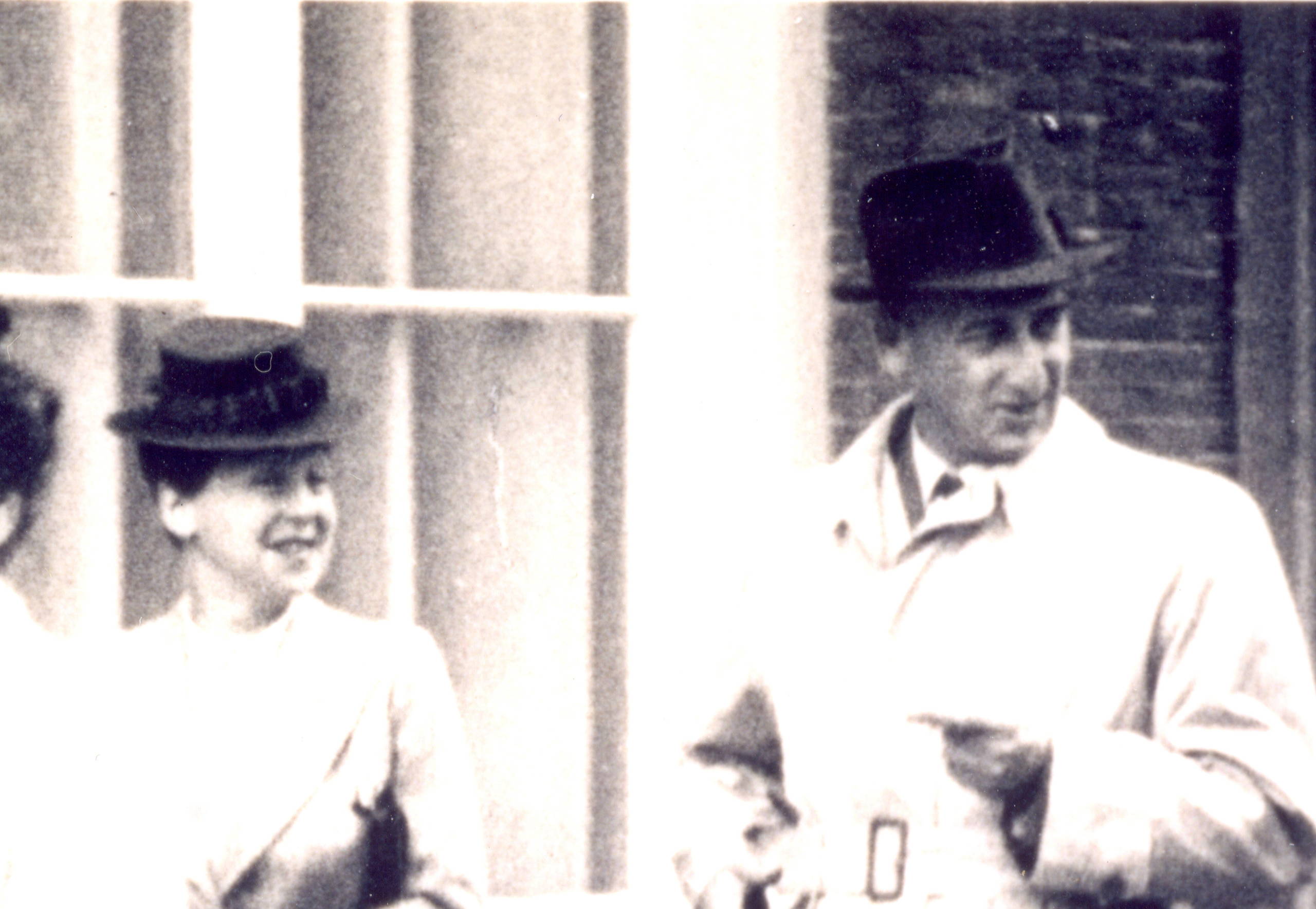
Auguste and Hermann van Pels at the wedding of Miep and Jan Gies, Amsterdam, 1941.
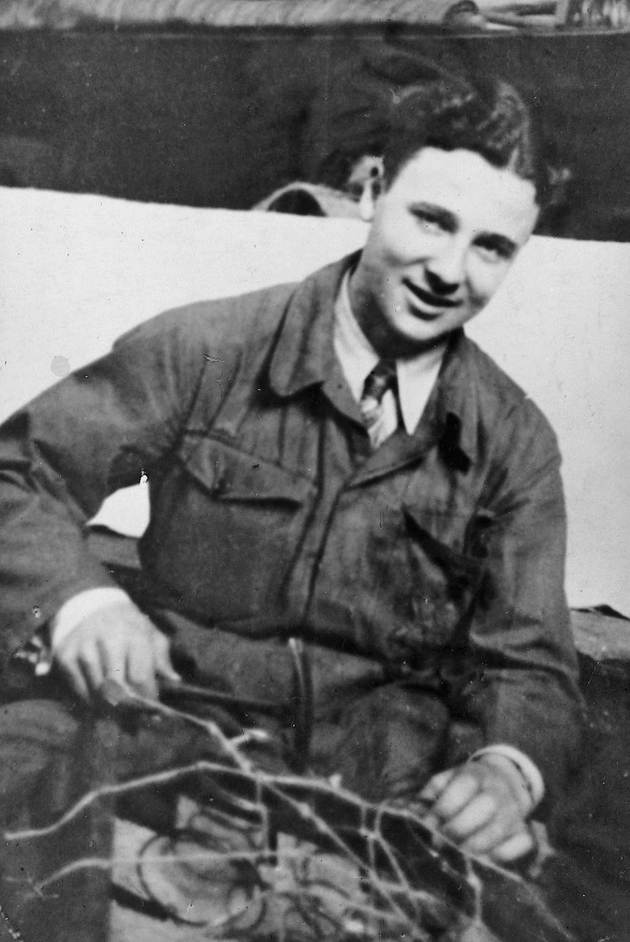
Peter van Pels, Amsterdam 1942.
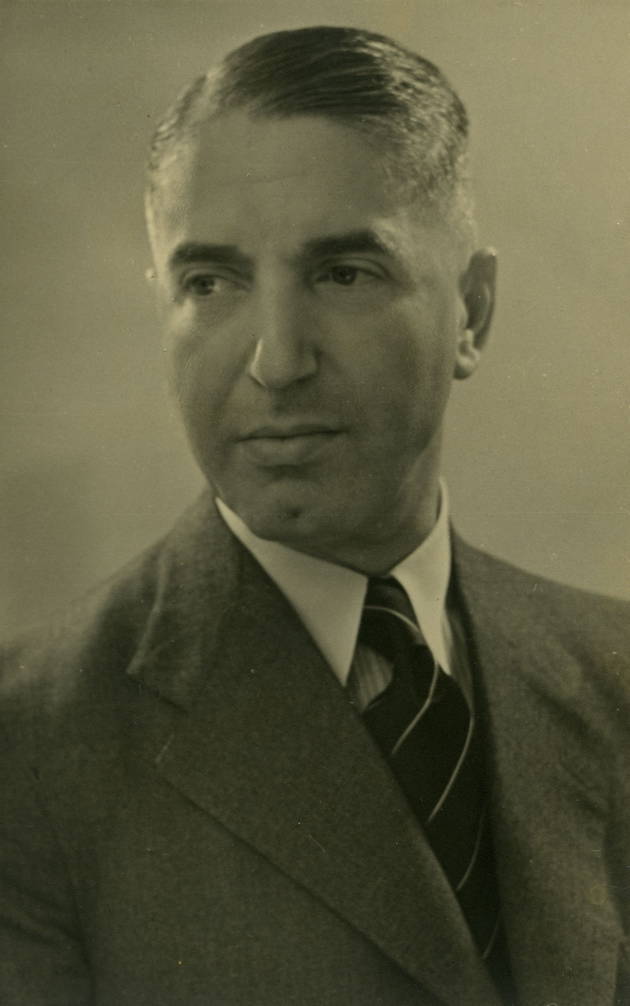
Fritz Pfeffer, around 1937.
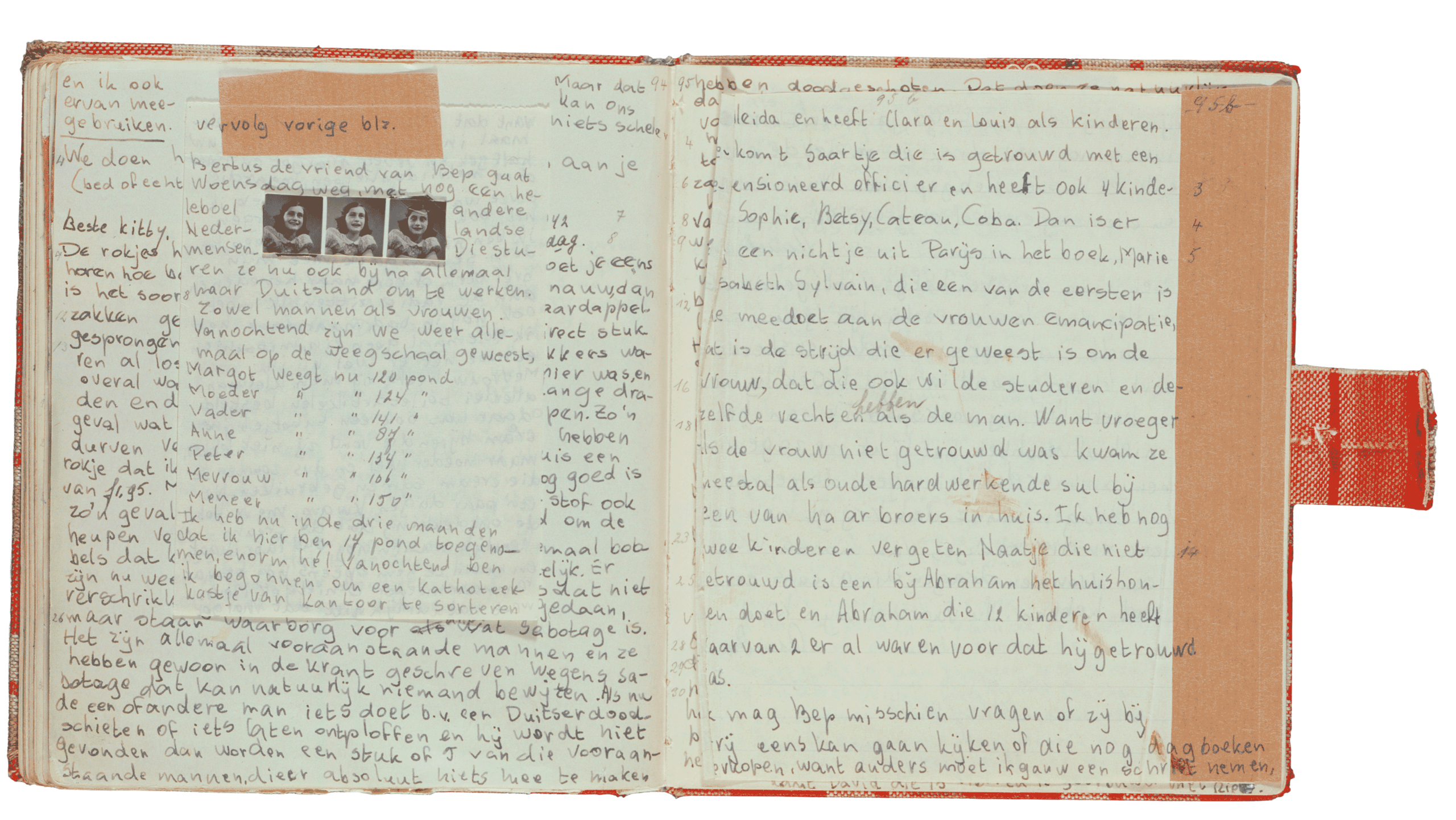
Double page of diary 28.9.1942. © Anne Frank Fonds Basel
When on 5 July 1942 the Frank family prepared to go into hiding in the secret annex, her diary was one of the first things that Anne packed:
«Margot and I started packing our most important belongings into a satchel. The first thing I stuck in was this diary, and then curlers, handkerchiefs, schoolbooks, a comb and some old letters.» (Diary, 8. July 1942)
During all her time in the secret annex Anne writes in her diary, documenting everything that happens, whether good or bad.
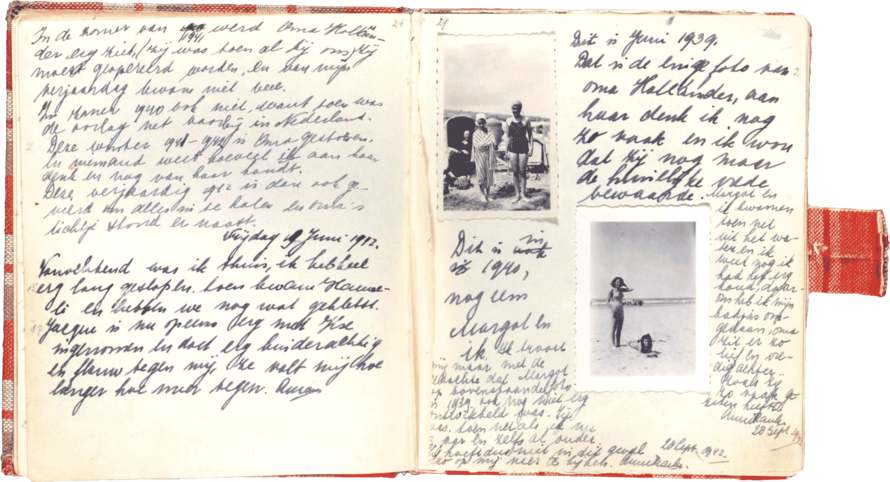
Double page of diary 18.10.1942. © Anne Frank Fonds Basel
In the secret annex, the diary becomes Anne’s very personal free space, the place where she can write about everyday life with the other seven . The hidden apartment is above the warehouse of Opekta, a company producing pectin for jam-making that her father Otto had established in Amsterdam. For this reason, apart from the weekends, their days are strictly structured by the working hours of the warehouse employees who know nothing about the secret annex and must not hear any noise made by those in hiding. This means that all eight inhabitants of the secret annex have to be extremely quiet.
Otto Frank encourages his daughters and Peter van Pels to continue with their studies so that they won’t have to repeat a year at school when the war is over. The helpers regularly bring the children new books from the lending library and various distance learning courses.
The five helpers – Miep Gies, Bep Voskuijl, Johannes Kleiman, Victor Kugler and Jan Gies – supply everything the eight inhabitants of the secret annex need to survive. Without their organisational talent and discretion, it would not have been possible to live in hiding for two years. They come by every day with food acquired from the black market, reading material, and stories from the outside world.
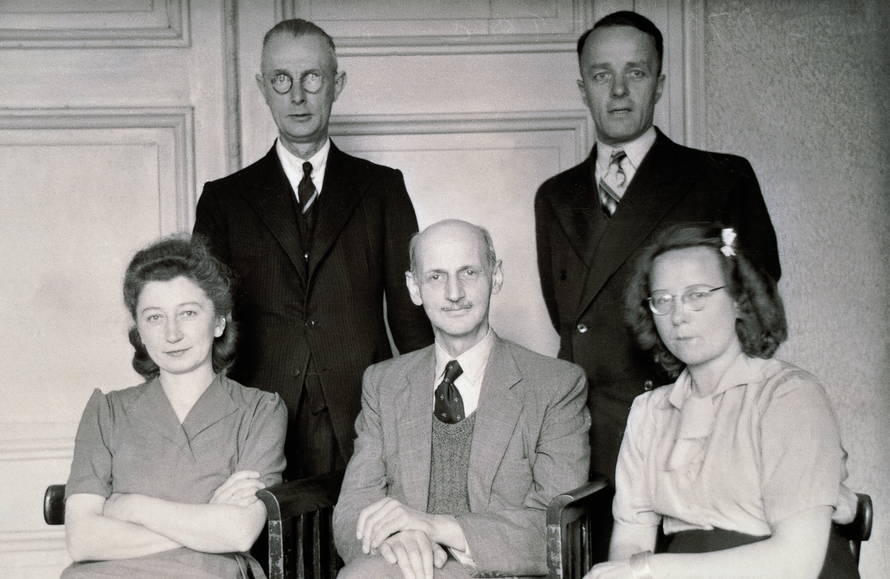
Otto Frank with his employees, who later helped with the escape. Miep Gies, Johannes Kleiman, Otto Frank, Victor Kugler, and Bep Voskuijl (from left to right). Jan Gies is missing from the picture. Amsterdam, 1935. © Anne Frank Fonds, Basel
«Never have they uttered a single word about the burden we must be, never have they complained that we’re too much trouble. They come upstairs every day and talk to the men about business and politics, to the women about food and wartime difficulties and to the children about books and newspapers. They put on their most cheerful expressions, bring flowers and gifts for birthdays and special occasions and are always ready to do what they can. That’s something we should never forget; while others display their heroism in battle or against the Germans, our helpers prove theirs every day by their good spirits and affection.»
Diary, 28. January 1944
Anne Frank describes her life in great detail: it is marked by the fear of being discovered, but also by arguments and disagreements that inevitably arise among the eight, given the claustrophobic conditions.
Persecuted and in hiding, Anne’s situation makes it impossible for her to spend her days like any youth, with free spaces and friends she has chosen herself. Anne lives in constant fear of discovery, in deadly terror during bombings and shootings, and in continual close contact with the other seven people in hiding.
«As I’ve written many times before, moods have a tendency to affect us quite a bit here, and in my case it’s been getting worse lately.
‘Himmelhoch jauchzend, zu Tode betrübt’* certainly applies to me. I’m ‘on top of the world’ when I think of how fortunate we are and compare myself to other Jewish children, and ‘in the depths of despair’ when, for example, Mrs Kleiman comes by and talks about Jopie’s hockey club, canoe trips, school plays and afternoon teas with friends.
I don’t think I’m jealous of Jopie, but I long to have a really good time for once and to laugh so hard it hurts. We’re stuck in this house like lepers, especially during winter and the Christmas and New Year holidays. Actually, I shouldn’t even be writing this, since it makes me seem so ungrateful, but I can’t keep everything to myself, so I’ll repeat what I said at the beginning: ‘Paper is more patient than people.’(…) Believe me, if you’ve been shut up for a year and a half, it can get to be too much for you sometimes. But feelings can’t be ignored, no matter how unjust or ungrateful they seem. I long to ride a bike, dance, whistle, look at the world, feel young and know that I’m free, and yet I can’t let it show. Just imagine what would happen if all eight of us were to feel sorry for ourselves or walk around with the discontent clearly visible on our faces. Where would that get us?
*A famous line from Goethe: ‘On top of the world, or in the depths of despair.»
Diary, 24. December 1943
In her diary Anne records her daily battle for independence and self-discovery. She describes the clashes with her mother while, at the same time, putting her father on a pedestal; she argues with the other adults, questioning them and their values. At the same time, she also observes and reflects on herself, at times unsparingly. And she writes with great openness about her changing body and her burgeoning sexuality.
Despite the daily disagreements and the constant fear, in her writing she time and again manages to find causes for optimism and humour and to full of hope envision future prospects.
In spring 1944, Anne and Peter van Pels, who is two years older than her, gradually fall in love with each other. Her writing makes it possible to trace their blossoming love and also the deep desire of these young people to be in love.
«What could be nicer than sitting before an open window, enjoying nature, listening to the birds sing, feeling the sun on your cheeks and holding a darling boy in your arms? I feel so peaceful and safe with his arm around me, knowing he’s near and yet not having to speak; how can this be bad when it does me so much good?»
Diary, 19. April 1944
On March 29, 1944, Anne hears a radio broadcast by Gerrit Bolkestein, Minister of education, art and science of the exiled Dutch government in London. He speaks of his plans to collect and publish personal testimonials such as letters and diaries to help people understand how the Dutch were oppressed by the German occupiers during the war. He suggests that Dutch citizens should preserve such documents and hand them over to the Dutch government after the war.
Anne, who already wanted to become a journalist or a writer previously, likes the idea. She starts editing her diary for later publication. Anne plans a novel entitled Het Achterhuis (The Secret Annex). To preserve the anonymity of the people living with her, she thinks up pseudonyms: the Van Pels family become the Van Daan family, and she calls the dentist Fritz Pfeffer, with whom she has frequent run-ins, Albert Dussel (“idiot” in German). She turns her own family name into Robin or Aulis, but this name is not used in the published versions of the diary.
Anne’s last entry is dated 1 August 1944. On 4 August, the eight people in hiding are arrested and initially sent to the Westerbork transit camp, before later being deported to Auschwitz.
After the raid by the Gestapo, Miep Gies found Anne’s writings scattered across the floor in the secret annex. She gathered them up and kept them in a drawer in the hope that one day she would be able to return them to Anne.
The diary with the red-and-white checked cover has become well-known. This is the first book that Anne was given in June 1942 and that she had filled to the very last page by December 1943. After that, Anne continued her diary in at least two exercise books.
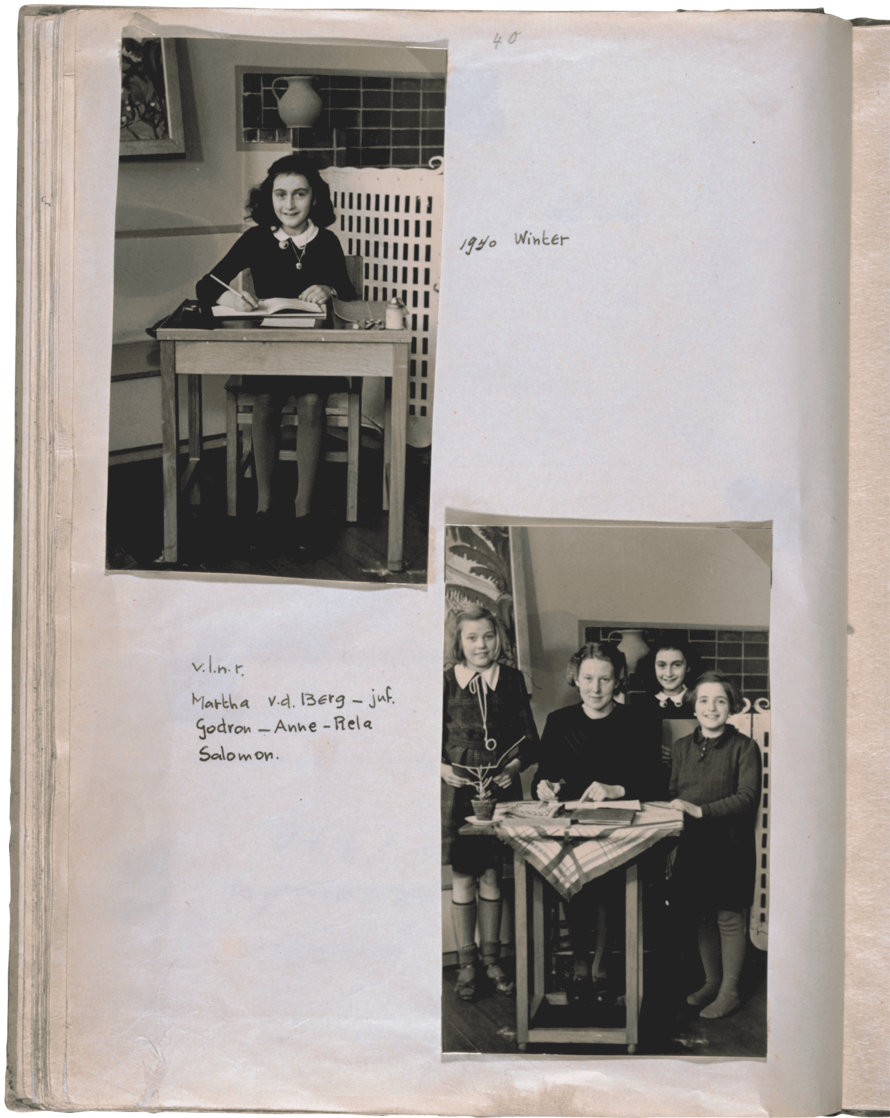
Anne Frank, Amsterdam 1940. © Anne Frank Fonds Basel
She edited her diary on loose sheets of paper, and more than 300 of them have been preserved. At the time of her arrest in August 1944, Anne had got to March 1944 in her editing work.
It is extremely likely that an exercise book with diary entries from December 1942 to December 1943 was lost, but the texts she edited from the same period have survived.
A bound notebook where she separately wrote down tales and events from life in the secret annex has also been preserved. Anne also used a slim cash book to record particularly impressive or beautiful sentences and passages from the books she was reading.